It is a thrilling time for fans of Tudor art. Not two weeks ago, news broke that a rare wooden falcon, sold at auction in 2019 for just £75, has been identified as an emblem of the ill-fated Queen Anne Boleyn. The object, about 20cm high, probably adorned her apartments in Hampton Court Palace, from the time of her coronation in 1533 until her execution in 1536. With its original paint and gilding intact, the falcon has been described as a ‘remarkable survivor’ by Tracy Borman, joint chief curator for Historic Royal Palaces.
Further excitement accompanied the Landmark Trust report on an astonishingly complete set of 16th-century decorative wall paintings, discovered during renovations at Calverley Old Hall in Yorkshire. These grotesque designs would have been based on German and Netherlandish printed images, ultimately inspired by the decoration of Nero’s Golden House in Rome, which had been discovered in the 1480s. Meanwhile, an extraordinary set of figurative paintings at The Star pub in Hoddesdon, Hertfordshire, was in the news again this month following a successful conservation check, having been originally uncovered in 2014. Conservators have suggested that the series of five figures, accompanied by Biblical verses, represent well-known Tudor personalities, including Elizabeth I and her chief advisor William Cecil.
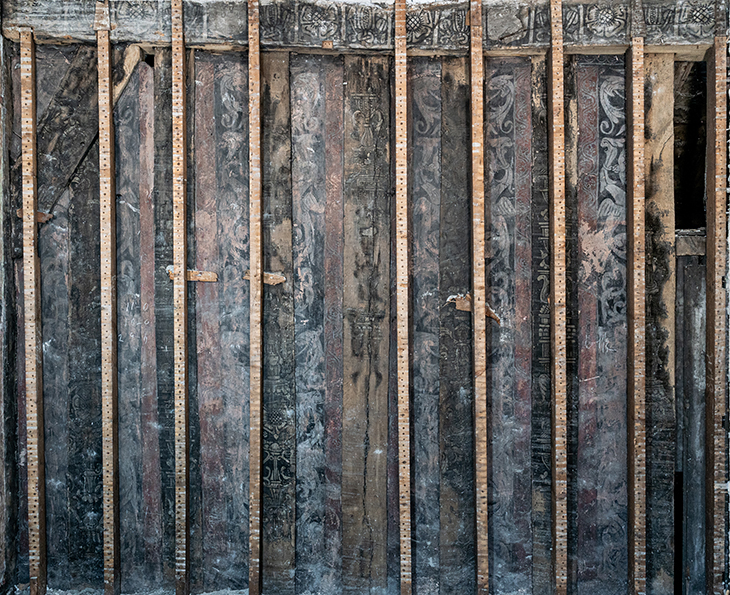
Wall paintings at Calverley Old Hall in Yorkshire. Photo: Tom Burrows; © Landmark Trust
The fact that, in 2021, such discoveries can become a matter of national interest shows how far our appreciation of Tudor art has progressed since the middle decades of the 20th century. At that time, a traditional emphasis on fine art meant objects such as these were often overlooked, but in more recent years art historians have broadened their horizons, turning their attention to the decorative arts, which were in many cases more valuable to Tudor patrons than oil paintings. Simultaneously, public interest in everyday Tudor life has been stirred by television, films and books such as Hilary Mantel’s Wolf Hall trilogy and Showtime’s series The Tudors. The resulting shift has inspired new scholarship on a range of fascinating objects, from carved furniture and plasterwork to tapestries and wall paintings. All the while, more examples are being discovered, studied and preserved.
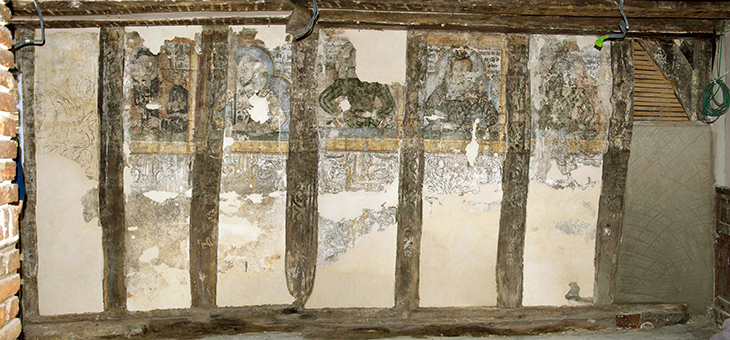
The uncovered wall paintings at The Star pub in Hoddesdon, Hertfordshire. Photo: Claudia Fiochetti
A poor survival rate makes it hard for us nowadays to imagine the sheer ubiquity of wall paintings, but in the Tudor period they were found in a huge variety of settings, from the great houses of the wealthy to local taverns. The two sets of wall paintings recently in the news represent both ends of this spectrum. Under different names, The Star in Hoddesdon has been a pub almost continuously since the 16th century, linked with a manor once owned by William Cecil, and sometime host to the manorial law court. Calverley Old Hall, on the other hand, is a medieval manor house, home to the Calverley family until 1754, and in the 16th and 17th centuries a witness to secret Catholic masses, rebellious plots and even a tragic murder.
For the Calverley family, the fashionable motifs of dragons, vases, scrolls and grotesques demonstrated their up-to-date taste. The designs recall the impressive grotesque schemes visible at the former Cross Inn in Oxford (now a Pizza Express), where William Shakespeare might once have stayed. At Calverley Old Hall, however, this Renaissance menagerie is balanced by more traditional Tudor roses and pomegranates in the frieze, symbolising loyalty to the crown – notwithstanding the fact that their probable patron, William Calverley, took part in the Pilgrimage of Grace, the largest Tudor rebellion. Pomegranates were associated with Catherine of Aragon, Henry VIII’s first (Catholic) wife, but also with her daughter, who was crowned Mary I in 1553. Archaeological investigations currently suggest a date range of 1547–85 for the paintings, meaning the pomegranates could symbolise loyalty to Mary, or continuing adherence to the Catholic faith even after Protestant Elizabeth I’s succession in 1558.
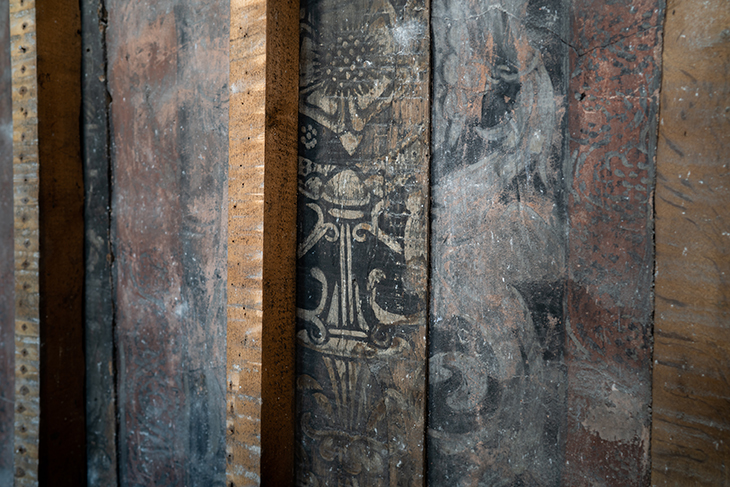
Wall paintings at Calverley Old Hall in Yorkshire. Photo: Tom Burrows; © Landmark Trust
The paintings at The Star in Hoddesdon date from the Elizabethan period, lending weight to the suggestion that the young woman with red hair shown in the scheme represents Elizabeth I herself. Another figure, with a moneybag and a pair of coin scales, has been tentatively identified as William Cecil, Lord High Treasurer under Elizabeth. If so, the accompanying Biblical quotation (‘For the desire of money is the root of all evil’) and reference to Luke 12:15 (‘Take heed and beware of covetousness: for though a man have abundance, yet his life standeth not in his riches’) provides a rather unflattering commentary on the queen’s arriviste advisor.
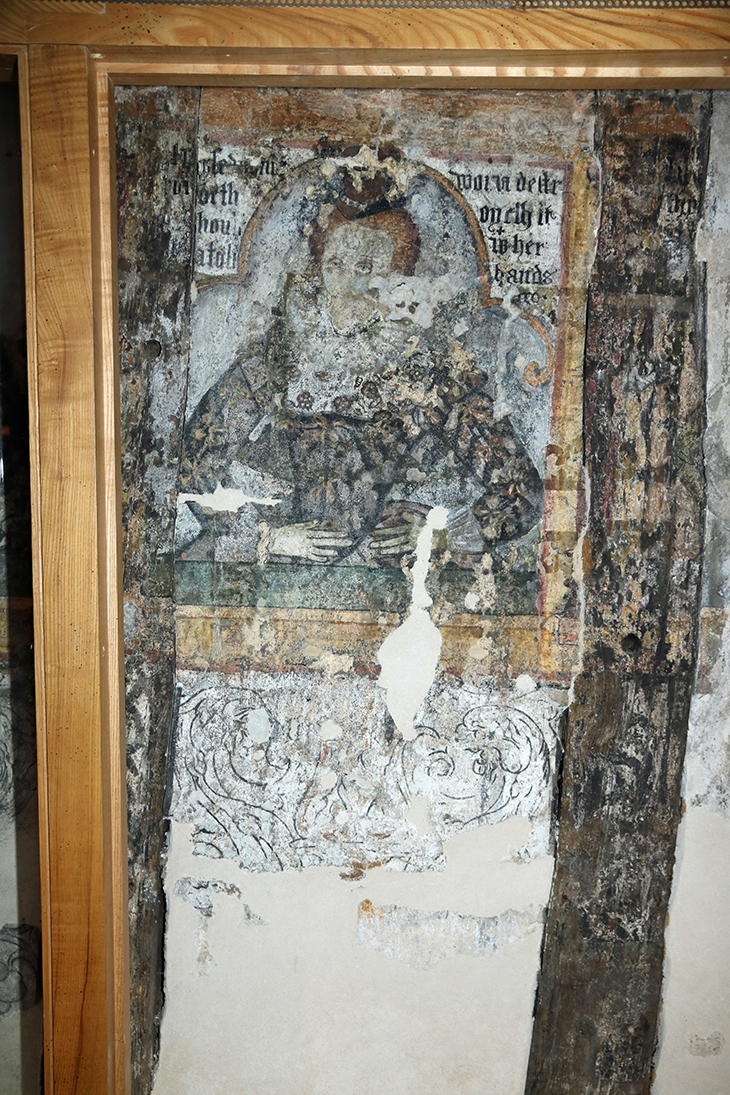
A figure resembling Elizabeth I, uncovered at The Star pub in Hoddesdon, Hertfordshire. Photo courtesy the Perry Lithgow Partnership Ltd
Perhaps more convincing is the suggestion that the figures represent virtues and vices: in this case the ‘Cecil’ figure could represent avarice. Moralising subjects were a common choice for wall paintings at this time, intended to encourage or admonish viewers towards good behaviour. This might seem an unlikely choice for pub decor, but we know that other moralising subjects, such as the parable of the prodigal son, were popular in taverns across the country. Meanwhile, the use of the building as the manorial court may have increased the desirability of moral and weighty subjects.
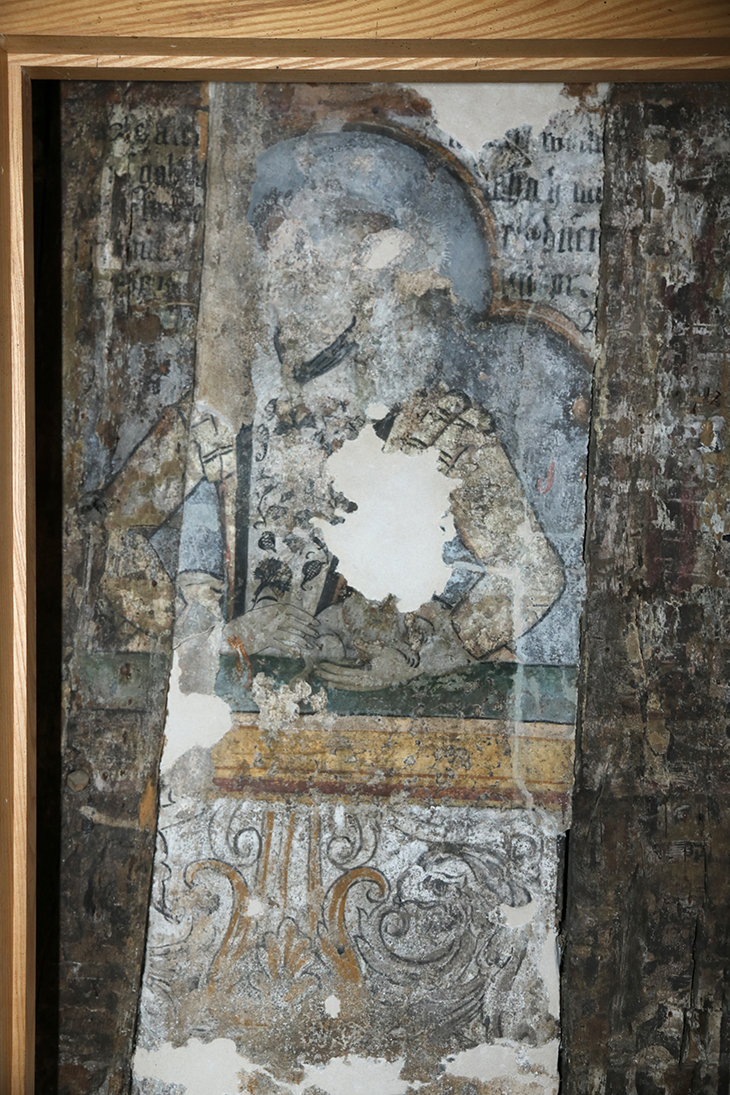
A female figure with lapdog uncovered at The Star pub in Hoddesdon, Hertfordshire. Photo courtesy the Perry Lithgow Partnership Ltd
This glut of new discoveries reveals how much there is still to find out about the art and material culture of Tudor England. Historians meanwhile can only hope that owners of other historic buildings will be encouraged to peek behind their plaster and see what lurks beneath.

The Tudor art lurking behind our wallpaper
Feathering the nest – a carved-oak falcon that probably adorned Anne Boleyn's apartments at Hampton Court Palace. Photo: Paul Fitzsimmons/Marhamchurch Antiques
Share
It is a thrilling time for fans of Tudor art. Not two weeks ago, news broke that a rare wooden falcon, sold at auction in 2019 for just £75, has been identified as an emblem of the ill-fated Queen Anne Boleyn. The object, about 20cm high, probably adorned her apartments in Hampton Court Palace, from the time of her coronation in 1533 until her execution in 1536. With its original paint and gilding intact, the falcon has been described as a ‘remarkable survivor’ by Tracy Borman, joint chief curator for Historic Royal Palaces.
Further excitement accompanied the Landmark Trust report on an astonishingly complete set of 16th-century decorative wall paintings, discovered during renovations at Calverley Old Hall in Yorkshire. These grotesque designs would have been based on German and Netherlandish printed images, ultimately inspired by the decoration of Nero’s Golden House in Rome, which had been discovered in the 1480s. Meanwhile, an extraordinary set of figurative paintings at The Star pub in Hoddesdon, Hertfordshire, was in the news again this month following a successful conservation check, having been originally uncovered in 2014. Conservators have suggested that the series of five figures, accompanied by Biblical verses, represent well-known Tudor personalities, including Elizabeth I and her chief advisor William Cecil.
Wall paintings at Calverley Old Hall in Yorkshire. Photo: Tom Burrows; © Landmark Trust
The fact that, in 2021, such discoveries can become a matter of national interest shows how far our appreciation of Tudor art has progressed since the middle decades of the 20th century. At that time, a traditional emphasis on fine art meant objects such as these were often overlooked, but in more recent years art historians have broadened their horizons, turning their attention to the decorative arts, which were in many cases more valuable to Tudor patrons than oil paintings. Simultaneously, public interest in everyday Tudor life has been stirred by television, films and books such as Hilary Mantel’s Wolf Hall trilogy and Showtime’s series The Tudors. The resulting shift has inspired new scholarship on a range of fascinating objects, from carved furniture and plasterwork to tapestries and wall paintings. All the while, more examples are being discovered, studied and preserved.
The uncovered wall paintings at The Star pub in Hoddesdon, Hertfordshire. Photo: Claudia Fiochetti
A poor survival rate makes it hard for us nowadays to imagine the sheer ubiquity of wall paintings, but in the Tudor period they were found in a huge variety of settings, from the great houses of the wealthy to local taverns. The two sets of wall paintings recently in the news represent both ends of this spectrum. Under different names, The Star in Hoddesdon has been a pub almost continuously since the 16th century, linked with a manor once owned by William Cecil, and sometime host to the manorial law court. Calverley Old Hall, on the other hand, is a medieval manor house, home to the Calverley family until 1754, and in the 16th and 17th centuries a witness to secret Catholic masses, rebellious plots and even a tragic murder.
For the Calverley family, the fashionable motifs of dragons, vases, scrolls and grotesques demonstrated their up-to-date taste. The designs recall the impressive grotesque schemes visible at the former Cross Inn in Oxford (now a Pizza Express), where William Shakespeare might once have stayed. At Calverley Old Hall, however, this Renaissance menagerie is balanced by more traditional Tudor roses and pomegranates in the frieze, symbolising loyalty to the crown – notwithstanding the fact that their probable patron, William Calverley, took part in the Pilgrimage of Grace, the largest Tudor rebellion. Pomegranates were associated with Catherine of Aragon, Henry VIII’s first (Catholic) wife, but also with her daughter, who was crowned Mary I in 1553. Archaeological investigations currently suggest a date range of 1547–85 for the paintings, meaning the pomegranates could symbolise loyalty to Mary, or continuing adherence to the Catholic faith even after Protestant Elizabeth I’s succession in 1558.
Wall paintings at Calverley Old Hall in Yorkshire. Photo: Tom Burrows; © Landmark Trust
The paintings at The Star in Hoddesdon date from the Elizabethan period, lending weight to the suggestion that the young woman with red hair shown in the scheme represents Elizabeth I herself. Another figure, with a moneybag and a pair of coin scales, has been tentatively identified as William Cecil, Lord High Treasurer under Elizabeth. If so, the accompanying Biblical quotation (‘For the desire of money is the root of all evil’) and reference to Luke 12:15 (‘Take heed and beware of covetousness: for though a man have abundance, yet his life standeth not in his riches’) provides a rather unflattering commentary on the queen’s arriviste advisor.
A figure resembling Elizabeth I, uncovered at The Star pub in Hoddesdon, Hertfordshire. Photo courtesy the Perry Lithgow Partnership Ltd
Perhaps more convincing is the suggestion that the figures represent virtues and vices: in this case the ‘Cecil’ figure could represent avarice. Moralising subjects were a common choice for wall paintings at this time, intended to encourage or admonish viewers towards good behaviour. This might seem an unlikely choice for pub decor, but we know that other moralising subjects, such as the parable of the prodigal son, were popular in taverns across the country. Meanwhile, the use of the building as the manorial court may have increased the desirability of moral and weighty subjects.
A female figure with lapdog uncovered at The Star pub in Hoddesdon, Hertfordshire. Photo courtesy the Perry Lithgow Partnership Ltd
This glut of new discoveries reveals how much there is still to find out about the art and material culture of Tudor England. Historians meanwhile can only hope that owners of other historic buildings will be encouraged to peek behind their plaster and see what lurks beneath.
Unlimited access from just $16 every 3 months
Subscribe to get unlimited and exclusive access to the top art stories, interviews and exhibition reviews.
Share
Recommended for you
England’s rich heritage is writ large on its walls – and must be safeguarded
An astonishing number of historic wall paintings have survived religious upheaval, climate-related damage and the passage of time. But they need our protection
The traces of the Tudor palace at Greenwich are a truly remarkable find
Archaeological discoveries at Greenwich are rare – which makes finding the remains of the Tudor palace even more significant
The Aztec origins of John Dee’s famous mirror are quite the mystery
The discovery that the astrologer’s ‘scrying glass’ is made of obsidian from Mexico points to the complex global webs surrounding many Tudor objects